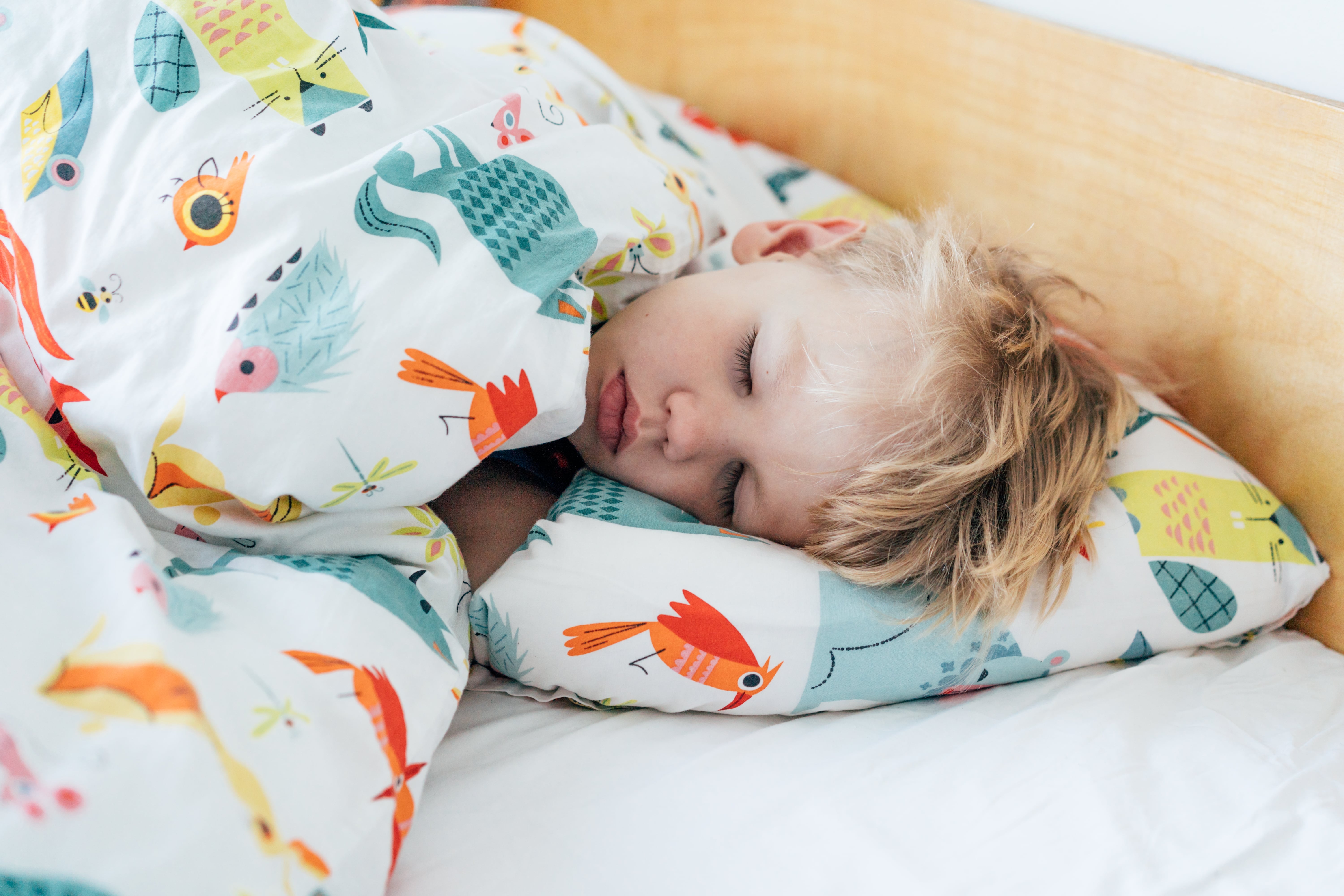By: Lynn Matuszewski, Certified Sleep Consultant
Did you know that proper sleep can give your little ones superpowers? Sleep is as important to overall health as eating right and getting daily activity. We get so busy with life that it is easy to push sleep aside making other tasks a priority. When your child (and the whole family) sets up a foundation for healthy sleep, each day will flow easier, and superpowers will have the opportunity to be developed.
Benefits of Good Sleep Habits
There are so many benefits that come from setting up healthy sleep habits for your kids, such as…
- Increasing overall mood and behavior: The right amount of sleep will help decrease meltdowns and tantrums. We are all in a better mood after we get the sleep we need!
- Strengthening immune systems: Sleep gives the body time to heal and regenerate. So even if your child does get sick, if they are well-rested, they will bounce back quicker. The right amount of sleep will keep their immune system at peak levels.
- Improving cognitive abilities: A well-rested child is able to concentrate better, have a longer attention span, and is able to retain what they have learned.
- Better safety skills: A well-rested child has better judgment as well as improved hand-eye coordination. This will help children be safe as they run, jump, climb or ride.

Components of Good Sleep Habits
Healthy sleep habits consist of a number of elements and if you’re missing any of these important components, your child’s sleep can be affected. Let’s look at the different elements of building and maintaining healthy sleep habits for kids.
1. The Sleep Environment
Your child’s sleep environment can either support the production of melatonin or suppress it. Melatonin is the sleepy hormone that tells the body it is time to rest. This is the hormone that regulates the sleep/wake cycle.
Here’s what you need for a healthy sleep environment:
- Darkness is key! Make sure your child’s room is dark. This signals to the body that it’s time to sleep. Darkness supports your child’s melatonin and is a trigger to the mind and body that it is time to sleep. You can make the room dark by using blackout shades, blinds, curtains, or even a black trash bag. Darkness and light helps regulate our circadian rhythms. Double-check your child’s room to make sure there is no light peeking in through the shades in the early morning or during naptime.
- Use nightlights. If your child is at the age that fear might interfere with keeping the room dark, nightlights are fine. Choose a night light that is yellow, red, or amber as these colours will not interfere with melatonin production. Use a bulb between 4-7 watts since brighter bulbs can interfere with sleep.
- Ideal room temperature. Keep the room cool to make it comfortable for sleep. We all sleep better when we are cooler. It is recommended that you keep your child’s room between 20-22 degrees Celsius (68-72 degrees Fahrenheit). Make sure you dress your little ones for the season so they are not too hot or too cold. Sleep sacks are great in the colder months to keep your baby and toddlers comfortable.
- A quiet sleep environment. You can use a white noise machine, a fan, or an air conditioner to help mute the outside noise, especially while your child is transitioning from one sleep cycle to another. Make sure the white noise machine isn’t too loud or too close to your child’s bed or crib.
Pro Tip! Keep the white noise running all night long. This ensures that the sleep environment is the same each time your child wakes. Hearing the white noise as they transition sleep cycles will help to put them back to sleep.
2. Limit Blue Light Before Bed
Make sure to stop screen time and limit blue light exposure at least an hour before bedtime. This includes TV, computer games, phone, tablet, and internet usage. These activities make it hard for children (and adults) to calm down and can interfere with sleep. Blue light can stop or delay the natural production of melatonin for up to 1-2 hours.
Pro Tip! You can set up a docking station for all your electronics for charging outside the bedroom each night to keep the temptation of having these items close at hand.
3. Create a Sleep Routine
A child’s soothing sleep routine is important to help prepare their mind and body for sleep. Doing a consistent soothing routine before both naps and night sleep will be a signal to your child that is time to transition their body and mind to a calm and relaxed state. Children thrive on the consistency and structure that routine offers and is an important part of developing healthy sleep habits for kids.
Here are some recommendations for setting up your sleep routine:
- Set aside 20 to 30 minutes to give your child’s body time to relax and settle. Your routine should be calm and on the quiet side. You don’t want to have a dance party before bed. Save that for morning wake up!
- This is a great time to do some bonding with your child. Often our days are so busy doing errands that it’s hard to just stop. Leave your cell phone in another room when you start your routine. This will eliminate the possibility of disruptions or stimulations.
- Start the soothing routine before they are overtired or you will be fighting the biology of “The Second Wind.” If this happens then your child will have a much harder time going to sleep. The goal here is to catch your child before they reach the overtired state. The best way to avoid the overtired state is to offer an early bedtime.
- A soothing routine is as unique as your child. If you have an older child, you can choose what to include in the routine together. This routine should take place in a consistent location whenever possible.
- Naptime can be a shorter version of the bedtime routine. Always do this routine in the same order so that your kids know what is coming next.
Here are some examples of what you can include in your soothing sleep routine:
- A bath
- Brush teeth
- Change the baby’s diaper or have them go potty
- Turn on the white noise machine or fan
- Change into PJ’s
- Play a shadow game
- Rock in a rocking chair
- Yoga
- Read a story
- A relaxing song
-
Pro Tip! If your child is old enough, make the routine come to life with pictures. This is a fun activity to do with your kids. Make a sleep chart and draw or cut out pictures that include each step of your routine. Then your child can check it off when it is complete. If your child is a superhero fan, you can make this the theme of your chart. The chart helps keep everyone on track and assists in stopping bedtime stalling.
4. The Timing of Sleep
After 4 months of age (adjusted), your child is ready to change to a set schedule. There are certain times of the day that your child’s body naturally produces melatonin. If you offer sleep during those times your child will have an easier time falling asleep.
Here are some tips for the timing of sleep:
- Set consistent wake-ups and bedtimes each day. You can use an “Ok to Wake Clock” to help your toddler-age children understand when it is ok to get up. Even on weekends, keep the time within an hour of the weekday wake-up schedule.
- When setting up your consistent schedule for all naps and bedtime make sure your child is getting the right amount of sleep. The National Sleep Foundation recommends nightly sleep durations for all ages as follows:
- Newborn-(0-3 months of age):14-17 hours
- Infant-(4-11 months of age): 12-15 hours
- Toddler-(12 months-2years of age):11-14 hours
- Preschool-(3-5 years of age): 10-13 hours
- School Age-(6-13 years of age): 9-11 hours
- Teens-(14-17 years of age): 8-10 hours
Pro Tip! There are days that sleep gets off track with missed naps or extra busy schedules. On those days, it is recommended to have an earlier bedtime. This will help make up for any lost sleep.
About the Author
Lynn Matuszewski is a Certified Sleep Consultant with Good Night Sleep Site. Lynn has a Bachelor of Science in Elementary Education and Special Education with a background in healthcare. Good Night Sleep Site has plans to help set up healthy sleep foundations for newborns, babies, kids to teens, and adults. If you would like to know more about any of the programs she offers, click here to set up a free 15-minute discovery call.








